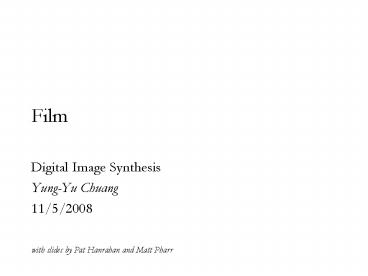Film - PowerPoint PPT Presentation
1 / 24
Title: Film
1
Film
- Digital Image Synthesis
- Yung-Yu Chuang
- 11/5/2008
with slides by Pat Hanrahan and Matt Pharr
2
Film
- Film class simulates the sensing device in the
simulated camera. It determines samples
contributions to the nearby pixels and writes the
final floating-point image to a file on disk. - Tone mapping operations can be used to display
the floating-point image on a display. - core/film.
3
Film
- class Film
- public
- Film(int xres, int yres)
- xResolution(xres), yResolution(yres)
- virtual Film()
- virtual void AddSample(Sample sample, Ray
ray, - Spectrum L, float
alpha) - virtual void WriteImage()
- virtual void GetSampleExtent(int xstart,int
xend, - int ystart, int
yend) - // Film Public Data
- const int xResolution, yResolution
Camera uses this to compute raster-to-camera
transform
4
ImageFilm
- film/image.cpp implements the only film plug-in
in pbrt. It simply filters samples and writes the
resulting image. - ImageFilmImageFilm(int xres, int yres,Filter
filt, - float crop4,string filename, bool premult, int
wf) - ...
- pixels new BlockedArrayltPixelgt(xPixelCount,
- yPixelCount)
- ltprecompute filter tablegt
write frequency
useful for debugging, in NDC space
5
AddSample
extent
sample
precomputed Filter table
find the nearest neighbor in the filter table
grid of pixels
6
WriteImage
- Called to store the final image or partial images
to disk - The device-independent RGB is converted to the
device-dependent RGB. First, convert to
device-independent XYZ. Then, convert to
device-dependent RGB according to your display.
Here, pbrt uses the HDTV standard. - Pbrt uses the EXR format to store image.
7
Portable floatMap (.pfm)
- 12 bytes per pixel, 4 for each channel
sign
exponent
mantissa
Text header similar to Jeff Poskanzers
.ppmimage format
PF 768 512 1 ltbinary image datagt
Floating Point TIFF similar
8
Radiance format (.pic, .hdr, .rad)
32 bits/pixel
red
green
blue
exponent
(145, 215, 87, 103) (145, 215, 87)
2(103-128) (0.00000432, 0.00000641,
0.00000259)
(145, 215, 87, 149) (145, 215, 87)
2(149-128) (1190000, 1760000, 713000)
Ward, Greg. "Real Pixels," in Graphics Gems IV,
edited by James Arvo, Academic Press, 1994
9
ILMs OpenEXR (.exr)
- 6 bytes per pixel, 2 for each channel, compressed
sign
exponent
mantissa
- Several lossless compression options, 21
typical - Compatible with the half datatype in NVidia's
Cg - Supported natively on GeForce FX and Quadro FX
- Available at http//www.openexr.net/
10
Tone mapping
- Converts HDR images to LDR image for display
- void ApplyImagingPipeline(float rgb,
- int xResolution, int yResolution,
- float yWeight,
- float bloomRadius, float bloomWeight,
- const char toneMapName,
- const ParamSet toneMapParams,
- float gamma, float dither,
- int maxDisplayValue)
- Not called in pbrt, but used by tools. It is
possible to write a Film plugin to call tone
mapping and store regular image.
weights to convert RGB to Y
11
Image pipeline
- Possibly apply bloom effect to image
- Apply tone reproduction to image
- Handle out-of-gamut RGB values
- Apply gamma correction to image
- Map image to display range
- Dither image
12
Bloom
without bloom
with bloom
blurred glow
a much brighter feel
13
Bloom
- Apply a very wide filter that falls off quickly
to obtain a filtered image - Blend the original image and the filtered image
by a user-specified weight to obtain the final
image
14
Tone mapping
- Two categories
- Spatially uniform (global) find a monotonic
mapping to map pixel values to the displays
dynamic range - Spatially varying (local) based on the fact that
human eye is more sensitive to local contrast
than overall luminance - core/tonemap.h, tonemaps/
class ToneMap public // ToneMap Interface
virtual ToneMap() virtual void Map(const
float y,int xRes,int yRes, float maxDisplayY,
float scale) const 0
input radiance array
displays limit
scale factor for each pixel
15
Maximum to white
- class MaxWhiteOp public ToneMap
- public
- // MaxWhiteOp Public Methods
- void Map(const float y, int xRes, int yRes,
- float maxDisplayY, float scale) const
- // Compute maximum luminance of all pixels
- float maxY 0.
- for (int i 0 i lt xRes yRes i)
- maxY max(maxY, yi)
- float s maxDisplayY / maxY
- for (int i 0 i lt xRes yRes i)
- scalei s
1. Does not consider HVS, two images different in
scales will be rendered the same 2. A small
number of bright pixels can cause the overall
image too dark to see
16
Results
input
max-to-white
17
Contrast-based scale
- Developed by Ward (1994) compress the range but
maintain the JND (just noticeable difference) - If the radiance is Ya, the difference larger than
?Y is noticeable. - Find s so that it
gives - We calculate the log average radiance as
real radiance
display radiance
18
Results
input
contrast-based
19
Varying adaptation luminance
- It computes a local adaptation luminance that
smoothly varies over the image. The local
adaptation luminance is then used to compute a
scale factor. - How to compute a local adaptation luminance? Find
most blurred value Bs(x,y) so that the local
contrast lc(x,y) is smaller than a threshold.
20
Varying adaptation luminance
- With the smooth local adaptation luminance image,
the scale can be computed in a similar way to
contrast-based method.
target display luminance
capacity function (intensity levels in terms of
JND)
21
Results
with fixed radius
base on local contrast
22
Spatially varying nonlinear scale
- Empirical approach which works very well in
practice. Similar to Reinhard 2002.
not the luminance Y, but the y component in XYZ
space
23
Results
input
nonlinear scale
24
Final stages
- Handle out-of-range gamut scale by the maximum
of three channels for each pixel (if the max gt
1.0) - Apply gamma correction inverse gamma mapping for
CRTs gamma mapping - Map to display range scaled by maxDisplayValue
(usually 255) - Dither image add some noise in pixel values































